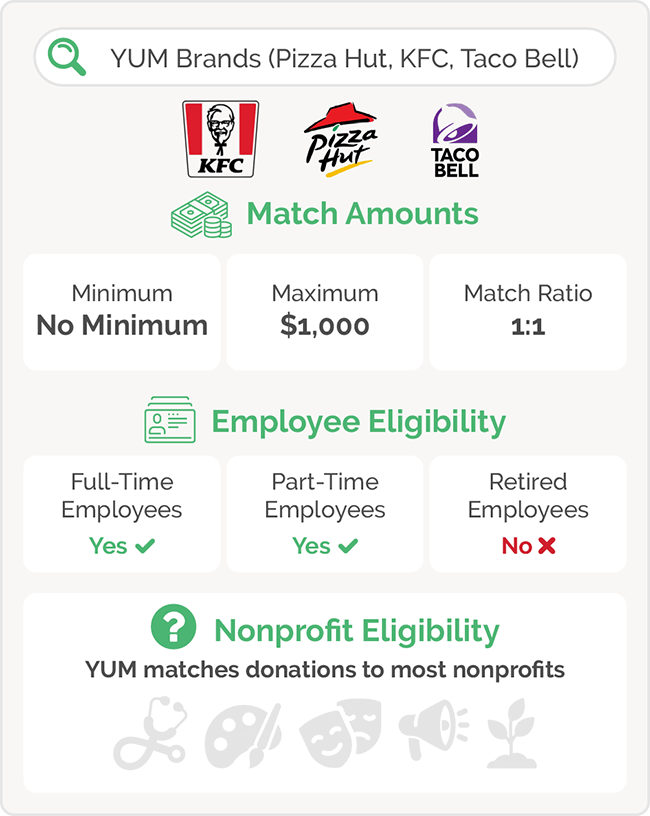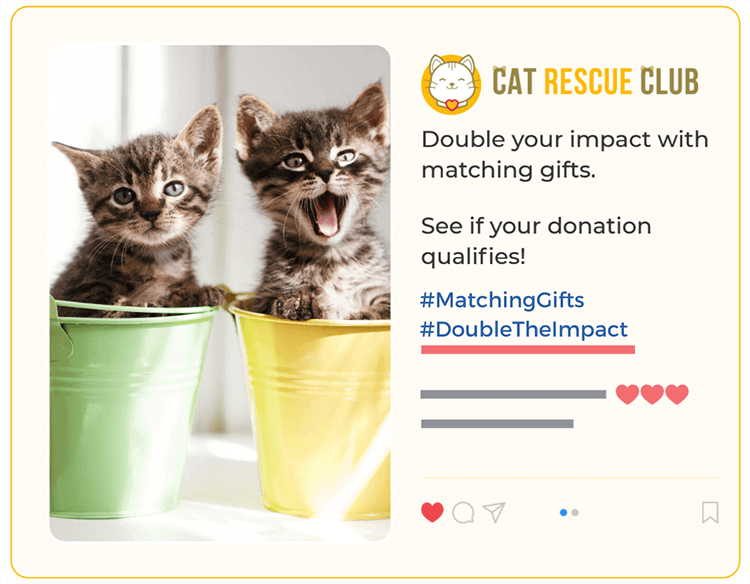
Companies that engage in corporate social responsibility (CSR) see greater employee and consumer support, but what about its impact on nonprofits?
No matter if you run an animal shelter, are researching a cure for Alzheimer’s, or fundraise for a college, corporate giving can provide vital resources. To help your nonprofit understand how these programs can impact your work, we’ll explore these key benefits:
- Greater Financial Support
- Donor Acquisition and Engagement
- Higher Volunteer Engagement
- Greater Marketing Power
- Event and Program Support
Understanding the benefits these opportunities offer will empower you to engage with businesses more effectively. Let’s start with the most well-known advantage.
Benefit 1) Greater Financial Support
Double the Donation’s CSR guide explains that businesses donate about $36 billion to nonprofits annually. With the right business connections, your organization can be one of those nonprofits.
Here’s a rundown of common ways companies financially support nonprofits:
- Direct donations: These donations can be used to cover anything your nonprofit needs, whether that’s operational costs, marketing, an event, or a specific program.
- Grants: Compared to direct donations, grants often provide less flexibility in how funds are used. Corporations can provide funding for specific projects via restricted grants. This approach allows businesses to contribute directly to the societal, environmental, or cultural initiatives they wish to support. While fewer in number, some businesses may offer unrestricted grant funding, which can be spent however your nonprofit chooses. Note that your nonprofit will need to apply for grants.
- Matching gifts: A company that offers matching gifts matches its employees’ contributions to eligible nonprofit organizations. That means your nonprofit can double contributions from individual donors.
- Volunteer grants: Many companies donate to nonprofits where their employees volunteer. After someone volunteers, they’ll submit a grant request with proof of their hours.
- Payroll giving: Several businesses let employees enable payroll deductions. That way, donors can regularly give without having to fill out your donation form each month. Think of it as a form of recurring giving.
As you can see, there are plenty of ways companies financially support nonprofits. To diversify your nonprofit’s income via corporate giving, research local companies whose philanthropic interests align with your mission. They may be willing to form a partnership in which they regularly donate or encourage their employees to give to your cause.
Benefit 2) Donor Acquisition and Engagement
One of the best ways CSR helps nonprofits with donor acquisition and engagement is through matching gift programs. While we mentioned matching gifts earlier, let’s take a moment now to shine a spotlight on the power of these programs. Matching gifts provide multiple corporate philanthropy benefits, including financial support and donor engagement.
In essence, companies match their employees’ contributions to eligible nonprofits. That makes donating more enticing and impactful. As part of their eligibilty guidelines, companies will set requirements for:

- Minimum and maximum match amounts
- A match ratio
- Employee status requirements
- Accepted types of nonprofits
Nonprofits Source’s corporate giving trends guide shares that companies are becoming more generous with these programs. For example, Coca-Cola offers a 2:1 match ratio, which means the company will donate twice as much as its employees. Meanwhile, American Eagle has raised its maximum match amount.
Finding Matching Gift Opportunities
Here’s how to identify matching gift opportunities and encourage donors to participate in this workplace giving program:
- Identify companies with matching gift programs. Compile a list of companies known for their matching gift programs. Many businesses publicly share information about their philanthropic efforts, including matching gifts, on their websites.
- Create a dedicated matching gifts page. Develop a section on your website where donors can learn about matching gifts. Include a searchable database of companies with matching gift programs.
- Feature matching gifts in donation acknowledgments. Whenever you thank donors, remind them to check if their employer will match their donation, potentially doubling their impact.
- Train your staff. Your fundraising team should be able to communicate this opportunity to donors and answer any questions they may have.
- Educate donors. Use your website, emails, and social media channels to educate supporters about matching gifts like the example below. Include simple instructions on how to check if their employer offers this program.

Matching gift software can help pinpoint these opportunities. It automates the process of identifying eligible donors and submitting their match requests. That means higher donor participation and more dollars for your cause.
Benefit 3) Higher Volunteer Engagement
Volunteers provide on-the-ground support for your nonprofit, and companies can be a great source of volunteers! Corporate volunteer programs bring additional manpower and enthusiasm to nonprofit projects. These individuals are excited to make an impact, meaning you’ll connect with new motivated supporters.
What’s more, skills-based volunteering opportunities give your nonprofit access to professional expertise you might not otherwise have. For instance, volunteers may lend pro-bono legal, marketing, or technology services. Whether you need help designing your website or creating an engaging email newsletter, volunteers skilled in marketing can help!
As we mentioned earlier, volunteer grants can help too. These grants will not only bring in additional funds but also drive volunteers’ impact further.
Benefit 4) Greater Marketing Power
Working with companies will naturally expand your audience. You’ll connect with a network of inspired donors and volunteers ready to make a difference. Here are common examples of corporate initiatives that’ll connect you with companies’ customers and employees:
- Volunteer programs inspire corporate employees to get involved in your cause.
- Event sponsorships put your nonprofit in front of the company’s partners, customers, and employees since they’ll promote the event to their networks.
- Donation drives actively fundraise for your nonprofit’s needs to employees and consumers.
- Cause marketing campaigns link your cause with a company’s products or services, introducing your nonprofit to the company’s customer base.
- Marketing grants, like the Google Ad Grant, provide nonprofits with resources to spend on marketing.
Remember that corporate partnerships should be mutually beneficial, so consider how you can promote your corporate partners in return. If these relationships go particularly well, businesses may even introduce you to other potential corporate partners!
Benefit 5) Event and Program Support
Your nonprofit probably runs various programs and hosts its fair share of fundraising events. Companies can step in to provide support for both!
Direct financial sponsorships from companies cover essential costs, enabling larger and more effective events and programs. Beyond direct financial support, in-kind donations alleviate additional financial burdens on nonprofits. Think along the lines of venue spaces, technology, auction items, and catering.
Moreover, employees bring a wealth of expertise to events and programs, enriching the experience and driving greater impact. Don’t forget how companies can also promote your events and programs to their networks, expanding your reach and increasing participation. However you go about it, businesses can support your events and programs in several impactful ways.
Start Using CSR to Push Your Mission Forward
Corporate support can expand your nonprofit’s potential. With businesses’ help, you’ll raise more money, expand your audience, and run events and programs more efficiently.
Get started by searching for these opportunities among your current supporters. The easiest way to do this is to find match-eligible donors or grant-eligible volunteers in your database. Then, encourage them to get involved. Research supporters’ employers and prioritize reaching out to those whose missions align with yours. In no time, you’ll build powerful corporate relationships that make a difference.